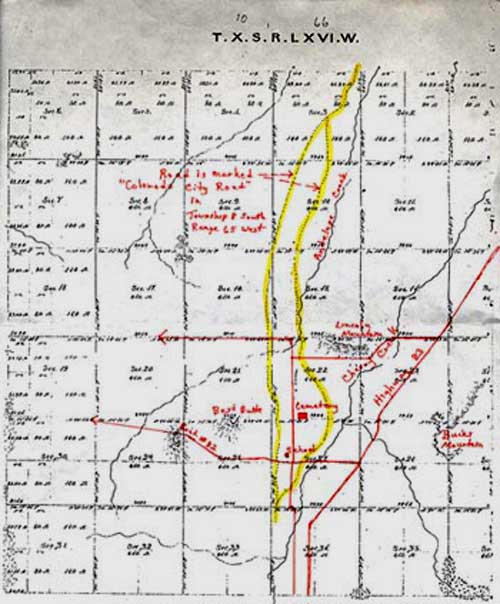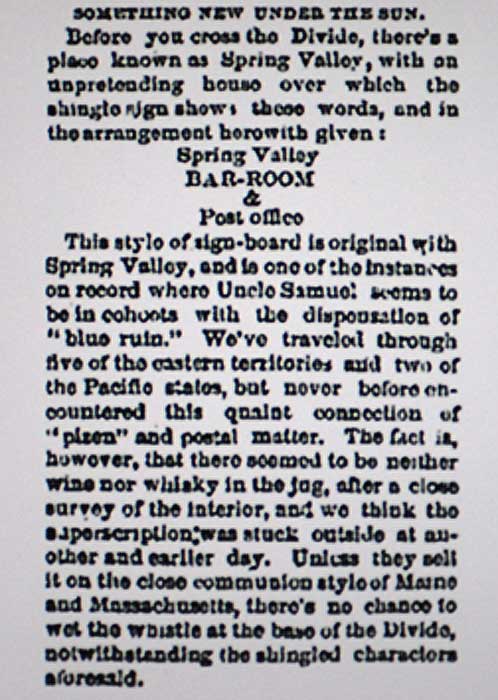| |
Spring Valley Timeline Overview
Millions of years ago this area was a lake and
even today fossils and shells can still be found. Elevation here is
7,000 feet making the native grasses some of the richest anywhere on
the Front Range. In addition to rolling grass lands, dense forests
of Ponderosa Pine, Douglas fir, Red Cedar, and Aspen grow well here.
Wildlife is plentiful with antelope, deer, rabbits, wild turkeys,
coyotes, mountain lions, and mountain goats. Many large birds nest
here such as hawks, turkey vultures, and eagles. Smaller birds like
robins, doves, finches, bobolinks, blackbirds, wild canary's and
hummingbirds are abundant. When Spring Valley was settled in 1860
buffalo were plentiful.
Mountain men inhabited the area from the Bijou Basin (just north of
Peyton) into Spring Valley. Game was abundant and Cherry Creek
provided trapping opportunities. It is said herds of 200 or more Elk
could be seen at a time.
The early settlement of Spring Valley comprising German, English,
Welsh and Irish settlers was of importance to Colorado from 1865
into the early 1900s. Most of the activity slowed down by 1885 when
the post office closed. The population was stated at 100 in 1887.
Beginning in 1860 this early settlement included the Spring Valley
School, a pioneer cemetery, grange store, blacksmith shop with
livery stable, a stage stop with hotel at the Gile Ranch and John
Iron's Fort. The exact location of which has never been determined.
In the Indian War of 1868 settlers were taking refuge near Spring
Valley at John Iron's on Cherry Creek. In 1874, Mary Schillinger, a
student at Spring Valley School, remembers 200 Ute Indians camped a
mile southeast of the school house during the month of July. Two
other Indian forts were in Southern Douglas County at this time one
being the Peoples Fort, sometimes referred to as
Oakes Folly,
located at Huntsville just northeast of
Larkspur and
Fort Washington
on the Ben Quick Ranch located west of Highway 105.

The first post office was established at the home
of George W. Redman who received appointment in April of 1865. The
next postmaster, Joseph Gile, retained the office from December 1865
until March of 1869 and indicated in a July 1868 post office
application that Bradley Barlow and Thomas Barnum would deliver mail
twice a week most probably at his stage stop.
Jacob Geiger became
postmaster April 26, 1882 and received mail at the Grange store
which he managed. The Spring Valley post office closed in 1885 and
the mail was delivered from Palmer Lake and Monument and later
relocated to Greenland.
George W. Redman, Joseph Gile, Jotham and
Joseph Lincoln, (two men
named) Sheldon and Spencer (first names unknown) and a small boy,
were the first settlers in the area in 1860. Jotham Lincoln and
another man were killed by Indians September 4, 1868. Jotham was
taken to his brother, Joseph's, home in Denver for funeral services
and it is unknown where his is buried.
Spring Valley was most notably significant for its location as a
stage stop on the west Cherry Stage Road from Frankstown south to
Colorado City, (now Manitou Springs) being the only settlement
between the two cities. The stop was located on the Gile Ranch,
which included a hotel in 1864. A toll road was established February
9, 1866 by Frankstown and Gile Station Wagon Road Company. The ruts
from the wagons can still be seen in the pasture just west of Spring
Valley School.

1867 Sept. 16, Rocky Mountain News. It is
believed that this was posted at the stage stop of Joseph Gile when
he was acting as post master. Thanks to
the Colorado Historic Newspaper Collection.
Potatoes, turnips, wheat and
oats were some of the crops grown. Around 1895, when potato crops were
good, potato bakes were held in Monument, Elbert and Elizabeth. It is
said important figures would be invited to come such as the Governor.
A general store was build west
of the school house and was managed for the
Divide Grange 53 by Jacob
Geiger who later purchased it from the grangers April 1, 1884.
The store mysteriously burned down April 13, 1885 after
Lorenzo
Leppert, a store merchant, came down with smallpox and had slept in
the back room of the store. Other dreaded diseases for early pioneers
and their children were diphtheria and scarlet fever as can be
evidenced by the gravestone at the
Spring Valley Cemetery.
Jacob and his brother, John, passed through Spring Valley during the
Civil war and later established homesteads around 1869. The
Geiger
family still ranches the original homestead of John's being the 5th
generation on the ranch.
The Spring Valley School shows up in 1865 in records of the Colorado
State Archives as the third school district in Douglas County. It is
unknown exactly when the existing structure was built since the
building was purportedly leased and no deed can be found. It is
known from newspaper articles that Divide Grange 53 met at the school
as early as 1878. The school was disbanded in 1946 and children sent
to other schools. Early schools were used for many other things such
as churches with traveling circuit preachers, grange meetings, court
hearings and funeral parlors.
The Spring Valley Cheese Company, established in 1894 by Jesse Knowles
and Newton Alderman, was located northeast of the schoolhouse site.
Because of the rich grass in the area dairy cattle ranches were
prevalent. Sometimes referred to as Tipperary many dances were held in
the big barn after the cheese operation was discontinued. It is said
that bootlegging was plentiful and the booze would be hidden in west
Cherry Creek and then picked up if not stolen first to take to the
dance. Many cheese factories were established in addition to Spring
Valley one being the Williams Cheese Factory in
Williamsville or
Cherry now known as the Emil Anderson Ranch and at the
Frink Creamery
in Larkspur, famous for Black Canyon Cheese.
As pioneers crossed the Platte Valley Divide, Spring Valley Cemetery
began as a burial site. Indians of the area avoided hillsides so early
travelers believed their loved ones would be safe. The back portion of
the cemetery was donated by William Holden to the people of Spring
Valley February 22, 1877. Later, in 1913, Newton Alderman sold an
additional two acres in front to provide access to Spring Valley Road.
Buried there are many pioneers of Douglas County; the oldest
identified graves are those of Horace Reynolds children buried in
1870.
Spring Valley Timeline by Years
- 1860: Joseph Franklin Gile comes to Denver and settles on the Palmer Divide
- July 10, 1860: Spring Valley is settled by George Redman, Lincoln, Joseph Gile, Sheldon, Spencer and “a small boy”.
- circa 1864: Jacob & John Geiger come through the area.
Jacob Geiger was wounded and given a Civil War grant of land in Spring Valley.
- 1864: Spring Valley Swing Station Stage stop in
operation on the Gile ranch and included a hotel.
- April 1865: A Post Office was established in the home of George W. Redman.
In December 1865 Joseph Gile succeeds Redman and holds the
position until March 1869.
- 1866: Frankstown and Giles Station Wagon Road Company incorporated (Gardner, Brackett, Gile).
- Feb 9, 1866: A toll road established from Frankstown to Spring Valley
by Frankstown and Gile Station Wagon Road Company.
- 1867: Spring Valley “shown on Cherry Creek & Denver-Fountain City Trail”
map. (notes of James Grafton Rogers).
- 1867: Area looted & burned by Indians.
- 1868: Settlers take refuge at John Irons Fort on Cherry Creek
during Indian uprising.
- September 5, 1868: Jotham Lincoln killed by Indians.
- July 1869: Little Giant Saw Mill, Bassett and Son operating near
Spring Valley.
- February 17, 1874: Divide Grange 53 organizes and incorporates
January 1878.
- July 1874: 200 Indians camped one mile
southeast of Spring Valley School.
- 1877: Scarlet Fever epidemic in the valley kills six of Joseph
Giles children.
- April 1, 1884: Grange store ceases business & sells out to Jacob Geiger.
- Jan 27, 1885: Lorenzo Leppert dies of smallpox, school children exposed.
- Feb 26, 1885: Janie Ritchey, finance of
Lorenzo Leppert, dies of smallpox.
- April 13, 1885: Spring Valley Store burns, never to reopen.
- July 3, 1885: Spring Valley Post Office closes.
- August 29, 1894: Jesse Knowles operating Spring Valley Cheese
Company.
- July 1895: Local ranchers have obtained assays of gold from
claims, they are working in the area.
- 1946: Spring Valley School closes.
|
|


